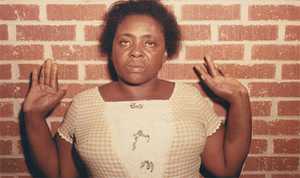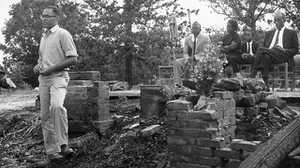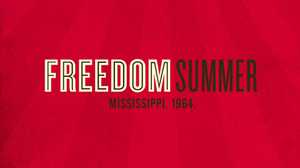Murder in Mississippi

On June 21, 1964, three young men disappeared near the town of Philadelphia, Mississippi. Michael (Mickey) Schwerner and James Chaney worked for the Congress of Racial Equality (CORE) in nearby Meridian; Andrew Goodman was one of the hundreds of college students from across the country who volunteered to work on voter registration, education, and Civil Rights as part of the 1964 Mississippi Summer Project. The three men believed their work was necessary, but also dangerous: Ku Klux Klan membership in Mississippi was soaring in 1964 -- with membership reaching more than 10,000. The Klan was prepared to use violence to fight the Civil Rights movement; on April 24 the group offered a demonstration of its power, staging 61 simultaneous cross burnings throughout the state.

Over the course of the summer of 1964, members of the Klan burned 20 black Mississippi churches. On June 16, Klan members targeted Neshoba County's Mt. Zion Baptist Church, where Schwerner had spent time working. Before burning the church, the Klan severely beat several people who had been attending a meeting there. Schwerner, however, was not there that day; he had gone to Oxford, Ohio, to train a group of Freedom Summer volunteers. Upon returning to Mississippi, Schwerner, Goodman and Chaney visited the charred remains of Mt. Zion. On the drive back to Meridian, their station wagon, known to law enforcement as a CORE vehicle, was stopped, and police arrested all three. Chaney, who had been driving, was charged with speeding, while Schwerner and Goodman were held for investigation. Neshoba County sheriff’s deputy Cecil Price escorted them to the Philadelphia jail around 4pm.

Despite the fact that the schedule of fines for speeding was posted on the wall, Price said the three men would have to remain in jail until the Justice of the Peace arrived to process the fine. Schwerner asked to make a phone call, but Price denied the request and left the jail. In Meridian, CORE staff began calling nearby jails and police stations, inquiring about the three men -- their standard procedure when organizers failed to return on time. Minnie Herring, the jailer’s wife, claimed there was no phone call on June 21, but CORE records show a call to the Philadelphia jail around 5:30pm.

Price returned a little after 10pm, collected Chaney’s speeding fine -- with no Justice of the Peace -- and told the three men to get out of the county. They were never seen alive again.
In 1964, Mississippi was the only state without a central FBI office, but on June 22, agents from the New Orleans office arrived to begin a kidnapping investigation. (Since passing in 1932, the “Lindbergh law” brought kidnapping cases under federal jurisdiction.) More agents would come to Mississippi over the next several days, ultimately totaling more than 200.

On June 23 investigators found the CORE station wagon, still smoldering from an attempt to destroy evidence; now the focus shifted from rescue to recovery of the men’s bodies.
The case was drawing national attention, in part because Schwerner and Goodman were both white Northerners. Mickey Schwerner's wife Rita, who was also a CORE worker, tried to convert that attention to the overlooked victims of racial violence. “The slaying of a Negro in Mississippi is not news. It is only because my husband and Andrew Goodman were white that the national alarm has been sounded,” she told reporters during the search.

Throughout July, investigators combed the woods, fields, swamps, and rivers of Mississippi, ultimately finding the remains of eight African American men. Two were identified as Henry Dee and Charles Moore, college students who had been kidnapped, beaten, and murdered in May 1964. Another corpse was wearing a CORE t-shirt. Even less information was recorded about the five other bodies discovered.
Finally, after six weeks of searching, a tip from an informant -- later identified as Mississippi Highway Patrol officer Maynard King -- sent investigators to an earthen dam on the Old Jolly
Farm outside Philadelphia. It was there that the FBI uncovered the bodies of Schwerner, Chaney, and Goodman on August 4.

Throughout the fall of 1964, the FBI continued investigating the case. State and local law enforcement did not pursue it, claiming insufficient evidence. Because murder was a crime covered by state law, the federal government could not bring charges. Instead, on December 4, the Justice Department charged 21 men with conspiring to violate Schwerner, Chaney, and Goodman’s civil rights.
Prosecutors brought the charges before a federal grand jury, which indicted 18 men in January 1965. The following month, presiding judge William Harold Cox dismissed the charges against the majority of the defendants, maintaining that the law applied only to law enforcement -- in this case, deputy sheriff Price, the county sheriff, and a patrolman. The prosecution appealed, and in 1966 the Supreme Court reinstated the charges, ruling that the law applied to both law enforcement officials and civilians.

In February 1967 another federal grand jury indicted the men once again, and in October the trial began in Judge Cox’s courtroom. Cox was known as a segregationist -- he had been the subject of an unsuccessful impeachment attempt after describing African American witnesses in an earlier case as “chimpanzees.” But on the first day of the trial, when the defense attorney asked a witness whether Schwerner was part of a plot to rape white women during the summer of 1964, Cox called the question improper, stating, “I’m not going to allow a farce to be made of this trial."
Prosecutor John Doar later called Cox’s response to the rape question a turning point in the fight for justice. “If there had been any feeling in the courtroom that the defendants were invulnerable to conviction in Mississippi, this incident dispelled it completely," Doar said afterwards. "Cox made it clear he was taking the trial seriously. That made the jurors stop and think: ‘If Judge Cox is taking this stand, we’d better meet our responsibility as well.'"
As the trial proceeded, the prosecution read the 1964 confessions of Horace Doyle Barnette and James Jordan, which described what happened on the night of June 21: After leaving Schwerner, Chaney, and Goodman in the Philadelphia jail, Cecil Price contacted Edgar Ray Killen, one of the leaders of the local Ku Klux Klan, who was also a Baptist minister. Killen directed Klan members to gather in Philadelphia that evening. When two cars filled with Klansmen headed for the outskirts of Philadelphia, Price released the Civil Rights workers from jail and ordered them to head back to Meridian. He then joined the pursuit of the CORE station wagon.

Catching up with the three Civil Rights workers on Highway 19, the Klansmen forced the men into their cars and drove all the vehicles to Rock Cut Road, a nearby side street. There, James Jordan shot Chaney, and Wayne Roberts shot Schwerner and Goodman. The killers loaded the bodies into the CORE station wagon and drove them to the Old Jolly Farm, where they used a bulldozer to bury the bodies in the earthen dam.
The jury found seven of the defendants guilty: Price, Barnette, Roberts, James Arledge, Billy Wayne Posey, James Snowden, and Samuel Bowers, the Imperial Wizard of Mississippi’s White Knights of the Ku Klux Klan. (Bowers had a particular antipathy toward Schwerner, and had begun planning his murder in the spring of 1964.) In three cases, the jury failed to reach a verdict; one juror refused to convict a minister, and Killen walked free. After unsuccessful appeals, the convicted men entered prison early in 1970. Each had received a sentence of between three and 10 years, but ultimately none would serve more than six years behind bars.

In 1998, Jerry Mitchell, an investigative reporter for the Jackson Clarion-Ledger, published excerpts from a 1984 interview with Samuel Bowers in which he spoke openly about the killings. “I was quite delighted to be convicted and have the main instigator of the entire affair walk out of the courtroom a free man, which everybody -- including the trial judge and the prosecutors and everybody else knows that that happened,” Bowers said. Mitchell’s reporting established that Bowers was referring to Killen. (The interview, which is now available to the public, was part of an oral history project to be held by the Mississippi Department of Archives and History and sealed until Bowers’ death. Mitchell, whose work on unsolved cases of the Civil Rights era earned him a 2009 MacArthur fellowship, never revealed how he got access to the interview.)
In 1999, Mississippi Attorney General Michael Moore announced that the state would reopen the case. At his request, the FBI turned over more than 40,000 pages related to the initial investigation. In January 2005, a grand jury charged Edgar Ray Killen with murder. Although several of the other conspirators were still alive at the time, the grand jury did not find sufficient evidence to indict anyone else. The trial drew national news coverage; members of the victims’ families were present at the trial, some as witnesses and some as observers. Ultimately, the jury found insufficient evidence for a murder conviction, but did find Killen guilty of the lesser charge of manslaughter. He was sentenced to 60 years in prison.








